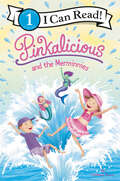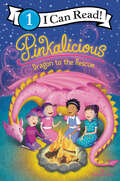- Table View
- List View
Pinkalicious and the Flower Fairy (I Can Read Level 1)
by Victoria KannCelebrate spring with Pinkalicious! #1 New York Times bestselling author Victoria Kann brings young readers a Pinkalicious I Can Read adventure about flowers and the power of imagination.Pinkalicious is absolutely positive that a flower fairy will visit her garden. After all, flower fairies love pink, and so does Pinkalicious! When Pinkalicious transforms her garden into a pink wonderland, will it entice the flower fairy to visit? Pinkalicious and the Flower Fairy is a Level One I Can Read book, which means it’s perfect for children learning to sound out words and sentences. Whether shared at home or in a classroom, the short sentences, familiar words, and simple concepts of Level One books support success for children eager to start reading on their own.Readers can watch Pinkalicious and Peterrific on the funtastic PBS Kids TV series Pinkalicious & Peterrific!
Pinkalicious and the Holiday Sweater (I Can Read Level 1)
by Victoria KannPinkalicious makes a pinktastic holiday sweater in this Level One I Can Read story, brought to you by #1 New York Times bestselling author Victoria Kann. Pinkalicious can’t wait to make Molly a holiday sweater for her Secret Snowman gift. But knitting a sweater is harder than it looks. Will Pinkalicious be able to make Molly the most pinkamazing and pinkadazzling holiday sweater ever?Pinkalicious and the Holiday Sweater is a Level One I Can Read, which means it’s perfect for children learning to sound out words and sentences. Whether shared at home or in a classroom, the short sentences, familiar words, and simple concepts of Level One books support success for children eager to start reading on their own.Readers can watch Pinkalicious and Peter on the funtastic PBS Kids TV series Pinkalicious & Peterrific!
Pinkalicious and the Merminnies (I Can Read Level 1)
by Victoria KannReaders can watch Pinkalicious and Peterrific on the funtastic PBS Kids TV series Pinkalicious & Peterrific!Pinkalicious and her friends have a mermazing time in this Level One I Can Read adventure that celebrates the power of friendship.Pinkalicious likes her new friend Splash the merminnie, even though he is a show-off. When Splash’s flashy tricks get him in trouble, it’s up to Pinkalicious and her friends to save him!Pinkalicious and the Merminnies is a Level One I Can Read, which means it’s perfect for children learning to sound out words and sentences.
Pinkalicious and the Perfect Present (I Can Read Level 1)
by Victoria KannReaders can watch Pinkalicious and Peterrific on the funtastic PBS Kids TV series Pinkalicious & Peterrific!#1 New York Times bestselling author Victoria Kann is back with a new I Can Read story featuring Pinkalicious! In Pinkalicious and the Perfect Present, Pinkalicious gets some money of her own to spend at a yard sale. To find the most pinkeriffic treasure for herself, Pinkalicious sorts through piles and piles of fabulous dress-up clothes, sports gear, and more. Yet when she finally finds the perfect purchase, Pinkalicious realizes it's even more perfect for her mother!Beginning readers and parents will love this warm Pinkalicious I Can Read story, which shows that the best gifts aren't the ones you receive but the ones you give. This is a Level One I Can Read book, which means it's perfect for children learning to sound out words and sentences.
Pinkalicious and the Pink Parakeet (I Can Read Level 1)
by Victoria KannReaders can watch Pinkalicious and Peterrific on the funtastic PBS Kids TV series Pinkalicious & Peterrific!#1 New York Times bestselling author Victoria Kann is back with a new I Can Read story featuring Pinkalicious!When Pinkalicious goes on a class trip to the birdhouse, she can't wait to see all the different birds—especially the rare pink parakeet! Pinkalicious sees lovebirds, peacocks, toucans, and even one very chatty parrot, but no parakeet—until she spies it escaping from the birdhouse! Everyone gets in a flap, and it's up to Pinkalicious to bring her feathered friend back home.This is a Level One I Can Read book that is perfect for children learning to sound out words and sentences.
Pinkalicious and the Pinkadorable Pony (I Can Read Level 1)
by Victoria KannPinkalicious and her family have a giddy-up good time in this new Level One I Can Read adventure down at the ranch, brought to you by #1 New York Times bestselling author Victoria Kann. When Pinkalicious visits the Pink Pines Ranch, she meets the most amazing mini-tastic miniature pony! When the peewee pony escapes her corral, it’s up to Pinkalicious to find her. Pinkalicious and the Pinkadorable Pony is Guided Reading Level K and a Level One I Can Read book, which means it’s perfect for children learning to sound out words and sentences.
Pinkalicious and the Pinkamazing Little Library (I Can Read Level 1)
by Victoria KannPinkalicious loves reading so much, she can’t stop. The perfect Level One I Can Read to share with your book-loving beginning reader!An homage to reading from the #1 New York Times bestselling author Victoria Kann.Pinkalicious reads in bed, at the table, and even while she is walking. When Pinkalicious can't find any new books to read at the library, what does she do? She makes a pinkamazing little library. It’s booktastic!Pinkalicious and the Pinkamazing Little Library is a Level One I Can Read with a Guided Reading Level (GRL) of J, which means it’s perfect for children learning to sound out words and sentences. Whether shared at home or in a classroom, the short sentences, familiar words, and simple concepts of Level One books support success for children eager to start reading on their own.Readers can watch Pinkalicious and Peter on the PBS Kids TV series Pinkalicious & Peterrific!
Pinkalicious and the Pinkatastic Zoo Day (I Can Read Level 1)
by Victoria KannReaders can watch Pinkalicious and Peterrific on the funtastic PBS Kids TV series Pinkalicious & Peterrific!It's Teddy Bear Day at the zoo, and Pinkalicious and Peter are having a pinkatastic time with their teddy bears. The day is perfect until a sneaky monkey with an eye for teddy bears scoops up Pinkalicious's bear. How can Pinkalicious stop her from monkeying around?Pinkalicious and the Pinkatastic Zoo Day is a Level One I Can Read book, which means it’s perfect for children learning to sound out words and sentences.
Pinkalicious and the Pinkettes (I Can Read Level 1)
by Victoria Kann#1 New York Times bestselling author Victoria Kann brings young readers a Pinkalicious I Can Read adventure that celebrates creativity and resourcefulness! Rock out with Pinkalicious and her friends in this Level One I Can Read. Pinkalicious and her friends want to start a band, but they don’t have any instruments! Pinkalicious will need to find a creative answer. When Pinkalicious realizes there are amazing sounds all around, she figures out what to do. Pinkalicious and the Pinkettes is a Level One I Can Read book, which means it’s perfect for children learning to sound out words and sentences. Readers can watch Pinkalicious and Peterrific on the funtastic PBS Kids TV series Pinkalicious & Peterrific!
Pinkalicious and the Pirates (I Can Read Level 1)
by Victoria KannReaders can watch Pinkalicious and Peterrific on the funtastic PBS Kids TV series Pinkalicious & Peterrific!#1 New York Times bestselling author Victoria Kann brings young readers a Pinkalicious I Can Read pirate adventure about bravery, creativity, and making unlikely new friends.Pinkalicious and Peter go to the hidden cove to meet their friend Aqua, but the mini-mermaid is nowhere in sight. Instead, they see pirates…ARGHH!Pinkalicious and the Pirates is a Level One I Can Read book, which means it’s perfect for children learning to sound out words and sentences.
Pinkalicious and the Robo-Pup (I Can Read Level 1)
by Victoria KannFrom #1 New York Times bestselling author Victoria Kann comes a new Pinkalicious Level One I Can Read story in which Pinkalicious and her brand-new totally pinkamazing robo-pup compete in a pet contest!Pinkalicious can’t wait to show off her robo-pup to her friends! But when she brings robo-pup to the pet contest, her friends only want to look at Alison’s adorable new puppy instead. When Alison’s puppy gets lost during the Pinkville Pet Contest, can Pinkalicious and robo-pup help?Pinkalicious and the Robo-Pup is a Guided Reading Level J and a Level One I Can Read, which means it’s perfect for children learning to sound out words and sentences. Whether shared at home or in a classroom, the short sentences, familiar words, and simple concepts of Level One books support success for children eager to start reading on their own.Readers can watch Pinkalicious and Peter on the funtastic PBS Kids TV series Pinkalicious & Peterrific!
Pinkalicious and the Sick Day (I Can Read Level 1)
by Victoria KannReaders can watch Pinkalicious and Peterrific on the funtastic PBS Kids TV series Pinkalicious & Peterrific!#1 New York Times bestselling author Victoria Kann is back with a new I Can Read story featuring Pinkalicious!Pinkalicious gets to be Principal for a Day because she has perfect attendance! Pinkalicious can't wait to be in charge, but when she wakes up sick on the big day, will her dreams of being Principal Pinkalicious be—ACHOO!—blown away? Beginning readers will love seeing how Pinkalicious turns a sick day into a special day in this I Can Read adventure!This is a Level One I Can Read book that is perfect for children learning to sound out words and sentences.
Pinkalicious at the Fair (I Can Read Level 1)
by Victoria KannReaders can watch Pinkalicious and Peterrific on the funtastic PBS Kids TV series Pinkalicious & Peterrific!#1 New York Times bestselling author Victoria Kann brings young readers a Pinkalicious I Can Read Story about friendship and the magical unicorn, Goldilicious.Pinkalicious and Molly are headed to the Pinkville Fair and can’t wait to eat lots of pink cotton candy! But can Pinkalicious still have fun when it’s time to go and she can’t find her unicorn, Goldie?Pinkalicious at the Fair is a Level One I Can Read Book, which means it’s perfect for children learning to sound out words and sentences.
Pinkalicious: Cherry Blossom (I Can Read Level 1)
by Victoria KannReaders can watch Pinkalicious and Peterrific on the funtastic PBS Kids TV series Pinkalicious & Peterrific!#1 New York Times bestselling author Victoria Kann is back with a new I Can Read story featuring Pinkalicious!It's the pinkest day of the year! Thanks to a magical swirl of pink petals, Pinkalicious experiences a traditional Japanese cherry blossom celebration and learns to fly a kite with the help of a new friend.This is a Level One I Can Read book, which means it's perfect for children learning to sound out words and sentences.
Pinkalicious: Dragon to the Rescue (I Can Read Level 1)
by Victoria KannReaders can watch Pinkalicious and Peterrific on the funtastic PBS Kids TV series Pinkalicious & Peterrific!Pinkalicious and her friends have s’more fun in this new Pinkalicious I Can Read adventure brought to young readers by #1 New York Times bestselling author Victoria Kann. When Pinkalicious and her friends want to roast marshmallows at a backyard camping party, it’s too windy to keep the campfire lit! Luckily, Pinkalicious has a friend who can help. It’s Gertie the dragon to the rescue!Pinkalicious: Dragon to the Rescue is a Level One I Can Read, which means it’s perfect for children learning to sound out words and sentences.
Pinkalicious: Fairy House (I Can Read Level 1)
by Victoria KannReaders can watch Pinkalicious and Peterrific on the funtastic PBS Kids TV series Pinkalicious & Peterrific!A magical Pinkalicious I Can Read story from New York Times bestselling author Victoria Kann!Spring has sprung and Pinkalicious knows what that means—it's time for the fairies to arrive! Pinkalicious is convinced that the fairies live in her garden. Pinkalicious prepares by making sure the fairies have a pinkerrific place to stay. Welcome, fairies!Pinkalicious: Fairy House is a Level One I Can Read adventure and is carefully crafted using short sentences, familiar words, and simple concepts for children eager to read on their own.
Pinkalicious: Fashion Fun (I Can Read Level 1)
by Victoria KannReaders can watch Pinkalicious and Peterrific on the funtastic PBS Kids TV series Pinkalicious & Peterrific!#1 New York Times bestselling author Victoria Kann brings young readers a Pinkalicious I Can Read story about creativity, ingenuity, and fashion.Pinkalicious decides that she and her friends should play dress-up using her mother’s clothes. But when Mommy asks them to find something else to do, Pinkalicious comes up with a pinkerrific idea! She and her friends create pinkatastic outfits from household items, like coffee filters and macaroni.Pinkalicious: Fashion Fun is a Level One I Can Read book, which means it’s perfect for children learning to sound out words and sentences!
Pinkalicious: Fishtastic! (I Can Read Level 1)
by Victoria KannReaders can watch Pinkalicious and Peterrific on the funtastic PBS Kids TV series Pinkalicious & Peterrific!Pinkalicious and Peter have a magni-fish-cent time down at the dock in this new Pinkalicious I Can Read adventure brought to young readers by #1 New York Times bestselling author Victoria Kann.Pinkalicious wants to catch the pinkest fish in the sea when she goes fishing with Peter. What they catch isn’t pinkapretty...it’s even better!Pinkalicious: Fishtastic! is a Level One I Can Read, which means it’s perfect for children learning to sound out words and sentences.
Pinkalicious: Happy Birthday! (I Can Read Level 1)
by Victoria KannPinkalicious goes on a birthday adventure in this new Pinkalicious Level One I Can Read story, brought to you by #1 New York Times bestselling author Victoria Kann. Pinkalicious wants the most pinkatastic birthday party ever, and all she needs is some extra pink pizzazz. When she ties more and more balloons to her chair, she accidentally goes on a pinkamazing birthday adventure! Pinkalicious: Happy Birthday! is a Level One I Can Read, which means it’s perfect for children learning to sound out words and sentences. Whether shared at home or in a classroom, the short sentences, familiar words, and simple concepts of Level One books support success for children eager to start reading on their own.Readers can watch Pinkalicious and Peter on the funtastic PBS Kids TV series Pinkalicious & Peterrific!
Pinkalicious: Kindergarten Fun (I Can Read Level 1)
by Victoria Kann"Students who are learning to read will enjoy visiting a vibrant kindergarten classroom with Pinkalicious." —School Library JournalPinkalicious gets a kindergarten buddy in this Level One I Can Read, brought to you by #1 New York Times bestselling author Victoria Kann! Pinkalicious can’t wait to have a kindergarten buddy. But what if her buddy doesn’t like kindergarten? Will Pinkalicious be able to show her how pinkatastic it can be?Young readers in kindergarten now or getting ready for it will relate to Pinkalicious's hopes and be reassured by her friendship success.Pinkalicious: Kindergarten Fun is a Level One I Can Read book, which means it’s perfect for children learning to sound out words and sentences. Whether shared at home or in a classroom, the short sentences, familiar words, and simple concepts of Level One books support success for children eager to start reading on their own.Plus readers can watch Pinkalicious and Peter on the funtastic PBS Kids TV series Pinkalicious & Peterrific!
Pinkalicious: Kittens! Kittens! Kittens! (I Can Read Level 1)
by Victoria KannCute, colorful, and very lively kittens star in this Level One Pinkalicious I Can Read. Pinkalicious and Peter get a big surprise when their foster cat has kittens! Caring for six rambunctious kittens is a huge challenge. Will Pinkalicious and Peter be able to convince Mommy and Daddy to let them keep them?Pinkalicious: Kittens! Kittens! Kittens! is a Level One I Can Read which means it’s perfect for children learning to sound out words and sentences. Whether shared at home or in a classroom, the short sentences, familiar words, and simple concepts of Level One books support success for children eager to start reading on their own.Readers can watch Pinkalicious and Peter on the funtastic PBS Kids TV series Pinkalicious & Peterrific!
Pinkalicious: Lost In Paris (I Can Read Level 1)
by Victoria KannYoung readers will be swept up in Pinkalicious’s pinkatastic Parisian adventure in this Level One I Can Read!Pinkalicious gets distracted and loses track of Mommy, Daddy, and Peter on a family trip to Paris. But fortunately, Pinkalicious remembers Mommy's advice and knows what to do!Pinkalicious: Lost in Paris is a Level One I Can Read, which means it’s perfect for children learning to sound out words and sentences. Whether shared at home or in a classroom, the short sentences, familiar words, and simple concepts of Level One books support success for children eager to start reading on their own.Readers can watch Pinkalicious and Peter on the funtastic PBS Kids TV series Pinkalicious & Peterrific!
Pinkalicious: Message in a Bottle (I Can Read Level 2)
by Victoria KannPinkalicious and and her friend Molly visit the beach and discover a riddle to solve. When Pinkalicious and Molly find a message in a bottle, the riddle inside sends them on a pinkatastic adventure! Will the pinktectives solve the mystery?From #1 New York Times bestselling author Victoria Kann, Pinkalicious Message in a Bottle is is the first ever Level 2 Pinkalicious story!Level Two I Can Read books are geared for kids who read on their own but still need a little help. Whether shared at home or in a classroom, the engaging stories, longer sentences, and language play of Level Two books are proven to help kids take their next steps toward reading success.Plus readers can watch Pinkalicious and Peter on the funtastic PBS Kids TV series Pinkalicious & Peterrific!
Pinkalicious: Pink around the Rink (I Can Read Level 1)
by Victoria KannReaders can watch Pinkalicious and Peterrific on the funtastic PBS Kids TV series Pinkalicious & Peterrific!#1 New York Times bestselling author Victoria Kann brings young readers a Pinkalicious I Can Read story that will have them laughing until they get pink in the cheeks!After Pinkalicious colors her white ice skates with a cotton candy pink marker, she feels ready to spin, glide, and soar with the best of them. But as the color starts to run off of her skates, she is embarrassed. When Pinkalicious thought she was going to leave her mark on the skating rink, she didn't mean it so literally. . . . Pinkalicious: Pink Around the Rink is a Level One I Can Read book, which means it’s perfect for children learning to sound out words and sentences.
Pinkalicious: Pinkie Promise (I Can Read Level 1)
by Victoria KannReaders can watch Pinkalicious and Peterrific on the funtastic PBS Kids TV series Pinkalicious & Peterrific!#1 New York Times bestselling author Victoria Kann brings young readers a Pinkalicious I Can Read story of friendship and imagination.When Pinkalicious uses all of Alison’s pink paint in class, Pinkalicious knows just how to make it up to her best friend!Pinkalicious: Pinkie Promise is a Level One I Can Read book, which means it’s perfect for children learning to sound out words and sentences.
























